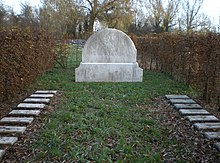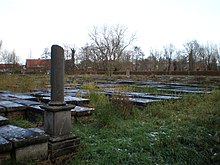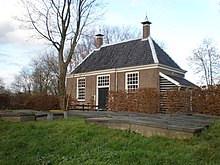Beth Haim (Ouderkerk aan de Amstel)
On the Jewish cemetery Beth Haim in the North Holland village of Ouderkerk aan de Amstel are about 28,000 Sephardic Jews , mainly from the northern Amsterdam , buried. The oldest Jewish cemetery in the Netherlands is still in use today.
location
The 4,115 hectare burial site is located in the immediate vicinity of the historic village center of Ouderkerk aan de Amstel in the municipality of Ouder-Amstel . The triangular cemetery area borders in the northwest on the Korendragerstraat and the Kerkstraat , where one of the two main entrances is located (Kerkstraat 10). In the northeast the church extends to the Koningin Julianalaan . In the south, the cemetery is bordered by the banks of the Bullewijk , a tributary of the Amstel . The second main entrance is behind a jetty located there, which can only be reached by boat.
history
prehistory
After the Jews were expelled from Spain in 1492, numerous Sephardic Jews settled in Amsterdam. Despite some strict regulations, the mostly wealthy immigrants in the liberal world trading city enjoyed freedoms that they had to do without in other European cities. In 1612, the Jewish community had not yet been given permission to build a synagogue . Church services in house synagogues were tolerated by the city administration. From 1607 the Sephardi buried their dead in the dunes near Groet in what is now the municipality of Bergen .
Creation of the cemetery
The first official recognition of Judaism in Amsterdam followed on May 29, 1614. The Staten van Holland approved the Jewish community in Ouderkerk aan de Amstel to buy a piece of land and to set up a cemetery there. This could be inaugurated in the same year. Between 1616 and 1634 the dead from the graves at Groet were reburied in Ouderkerk. In the years 1663, 1690 and 1691, the Gottesacker was considerably expanded through the acquisition of neighboring properties. At first, Ashkenazi Jews also found their final resting place on Beth Haim . These had originally immigrated to the Netherlands from Germany and Eastern Europe . In 1642 the Ashkenazi laid in the church today Muiden the Jewish cemetery Muiderberg on.
Second World War
During the Second World War, the German occupation of the Netherlands followed (1940 to 1945) and more than 100,000 Dutch Jews fell victim to the Holocaust . The renovation work started on Beth Haim in the 1930s with the assistance of the architect Harry Elte was stopped in 1940. The cemetery attendant Lou Alvares Vega, who has lived there since the summer of 1937, was granted a residence permit in Ouderkerk. The cemetery remained closed to visitors without a special permit that was valid for one day. Since relatives were not given any permits for the funeral of a family member, the guard Vega took care of the dignified burial of the dead alone.
From March 1943 , all Jews who died there were cremated in the Westerbork transit camp , a collection camp for deportation to the extermination camps in German-occupied Poland and Belarus , although their beliefs forbid this. After the Jews who had previously died in Westerbork were buried in the Jewish cemetery in Assen , the ashes were sent to Amsterdam after the introduction of cremation and from there to the Beth Haim cemetery, where Lou Alvares Vega was buried in a newly laid out section cared. On January 26, 1944, the last funeral took place under Vega, who a little later went into hiding with his family and thus survived the war. In December 1944 the guard's house was confiscated by the occupiers. By the end of the war, Salomon Mendes Coutinho and his wife Elisabeth Sarphati were responsible for the burial of more urns from the Westerbork concentration camp. The Beth Haim burial site was spared material damage by the National Socialists .
Beth Haim today
Since June 1967, the graves have been systematically recorded and restored under the direction of a foundation for the maintenance of Jewish cemeteries in the Netherlands. During the winter months some gravestones are protected from negative weather influences by tarpaulins. The city of Amsterdam contributed several times to the cost of renovating the cemetery buildings. About half of the 28,000 graves are still underground today due to the swampy soil. The renovation work is expected to take several years to complete.
construction
building
At the main entrance on Kerkstraat there is a caretaker's house from 1883, which was named after the cemetery attendant Lou Alvares Vega, who lived at Beth Haim from 1937 to 1944.
The Tahara House was built in 1705 in the style of a Dutch fisherman's house. It is located at the second main entrance behind the jetty on the Bullewijk river. Previously, it was common for the dead with Treidelbooten to transport to the cemetery and in the so-called Rodeamentoshuis also to wash. Inside there is a large hall with benches. There is a separate area for the Kohanim in the funeral home, as in the cemetery itself, since the priest is not allowed to come into contact with the deceased. Like the Portuguese Synagogue in Amsterdam , inaugurated in 1675, the building is not connected to the electricity grid.
Graves
One of the most striking features of the cemetery is a custom that the Jewish immigrants brought with them from Portugal and maintained. They did not arrange the tombstones standing, but lying down, which distinguishes Beth Haim from most other Jewish cemeteries. The oldest part of the burial ground (between the keeper's house and the morgue) contains the most interesting tombs. The tombstones, partly made of marble, are decorated with numerous symbols and motifs (faces, scenes from the Bible and mythology , skeletons, etc.). This tradition also comes from Portugal, where the Jews, known as Marranos, adopted many Catholic customs. South of the morgue on the banks of the Bullewijk is a section where the Kohanim are buried. The newest graves are located in the southeast area of the cemetery grounds.
memorial

In an area surrounded by a hedge there is an upright stone, in front of which there are small marble slabs. Under these lies the ashes of the Jews who died in the Westerbork concentration camp. Although according to Jewish belief the dead may not be cremated, the dead were allowed a final resting place here. On the front of the upright stone, commemorating the Holocaust , there is the following inscription in Dutch and Hebrew:
"OLIE VAN OLIJVEN, ZUIVERE GESTOTENE - GESTOTEN EN GESLAGEN OM LEED AS LIGHT TE DRAGEN"
"Oil from olives, pure and pounded - pounded and pounded to bear suffering as light"
The following sentence is written on the back in Dutch:
"IN SILENCE OOTMOET MEMORIES WIJ HET MATELOOS LEED DER WEGGEVOERDEN - 1940 1945"
"In quiet humility we remember the immeasurable suffering of the deportees - 1940 1945"
Others

- Beth Haim was the inspiration for the Dutch landscape painter Jacob Izaaksoon van Ruisdael for two paintings, both known as De Joodse Begraafplaats (The Jewish Cemetery).
- Due to its old stock of trees and some rare plants, the cemetery is also an important biotope in the densely populated and agriculturally intensively used Randstad .
- In Willemstad , the capital of the Netherlands Antilles , there is also a Jewish cemetery called Beth Haim.
Graves of famous personalities
- Samuel Pallache (1550-1616)
- Eliahu Montalto, physician to Maria de 'Medici (1567–1616)
- Isaac Uziel (? –1622)
- Abraham Cohen Herrera (1570-1639)
- Zacutus Lusitanus (1575–1642)
- Menasse ben Israel (1604–1657)
- Ephraim Bueno (1599-1665)
- Binjamin Mussaphia (-1674)
- Michael and Hana Debora de Spinoza, parents of Baruch Spinoza
- Jakob Sasportas (1610–1698)
- Uri Phoebus ha-Levi (1625-1715)
- Samuel Sarphati (1813–1866)
See also
literature
- Lydia Hagoort: Het Beth Haim van Ouderkerk. Lost, Hilversum 2005, ISBN 90-6550-861-9 .
Web links
Coordinates: 52 ° 17 ′ 42 ″ N , 4 ° 54 ′ 17 ″ E











